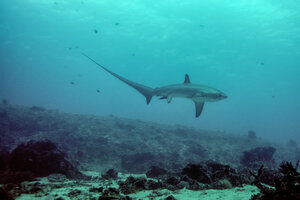Rare shark birth photographed for the first time, accidentally
A UK researcher hopes the photo will aid conservation efforts for the threatened species.

A pelagic thresher gives birth at Monad Shoal, Philippines.
Attila E. Bicskos (Kaszo)
A new photo depicting the live birth of a thresher shark could be the first of its kind – but what does it mean for a threatened species?
When University of Chester researcher Dr. Simon Oliver and photographer Attila Kaszo embarked on a diving expedition off the Philippine Malapascua Island in April 2013, it was to observe pelagic thresher sharks’ habits at “cleaning stations.” Threshers congregate at cleaning stations to allow smaller fish, like cleaner wrasse, to feed on dead tissue and parasites attached to their bodies. The mutualistic relationship between sharks and cleaner fish is well-documented, but the reproductive behaviors of pelagic threshers are not. So it came as a surprise to Kaszo when he caught a live shark birth on camera – totally by accident.
In an article published by the journal Coral Reefs, Oliver and Kaszo wrote, “... we observed a large female pelagic thresher shark swimming back and forth across a cleaning station in an agitated state. We were unable to decipher the cause of the shark’s distress from our observation post 15 m away, although it was evident that cleaner wrasse were taking bites from its pelvic region. We observed the shark for a total of 4 min, during which we took its photograph for identification purposes. The shark then left the cleaning station and was not observed again. Later, when we processed the photograph for analysis, it revealed the head of a pup emerging from the shark’s cloaca,” which is the opening for sharks’ reproductive organs.
Pelagic threshers are ovoviviparous. Their embryos develop inside eggs – as with most fish species – but the mother retains the eggs instead of laying them, ultimately resulting in live birth. Threshers generally give birth to a litter of two pups, which are born large (nearly half the size of the mother).
The pelagic thresher, along with a number of other oceanic sharks, was described as a vulnerable species by the IUCN in 2007. Dr. Simon Thorrold, a senior scientist from the Woods Hole Oceanographic Institution in Massachusetts, told BBC that the photo is “amazing,” but ultimately of “limited importance” to shark conservation.
But to Oliver, who is also the founder of The Thresher Shark Research and Conservation Project, the photo provides more than just novelty.
“... little is known of the reproductive strategies of most oceanic species," Oliver said. "While interactions among thresher sharks and cleaner fish are well documented at this site, this is the first time cleaners have been seen interacting with a marine organism while it gives birth.”
Oliver he hopes that the photo will emphasize the importance of the study site as not just a cleaning station, but a “pupping ground” – one that is “massively essential” to the species.
“By understanding that this site may also be a pupping area for thresher sharks," Oliver said, "we can inform conservation initiatives to protect it. The discovery underpins our knowledge of the essential nature of cleaning stations in the life strategies of this rare and vulnerable shark species.”

